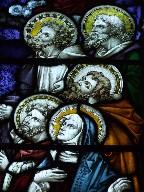| |
|
 |
|
This is a fine, grand,
little-visited church. It stands in
fields near the ornate gateway to
Assington Hall. But the Hall burned down
half a century ago, and now St Edmund has
a more exotic and somewhat surprising
neighbour, a field with llamas and
alpacas in it. You approach it by a
driveway from the Boxford to Bures
road. The whole church
was largely rebuilt in the 1860s, using
the original materials. The architect
seems to have been the vicar himself; not
as unusual as it sounds, in those days of
a renewal of interest in liturgy and
decoration. The church was largely
rebuilt in its original style, judging by
drawings from earlier in the 19th
Century; that is, of the late Medieval
period. Its tower is a grand one. It
would be interesting to see it in a
couple of centuries time, when it has
matured a bit.
|
To
the east of the church is one of the most
spectacular churchyard memorials in Suffolk, a
great column surmounted by angels, set on a base
which remembers generations of the Gurdon family.
It is the first inkling that this is a church to
come to if you have an interest in monuments; as
at Sotterley and Helmingham, you can
follow the lives (and deaths) of a single family
over the centuries.
Before
going inside, I pottered around the graveyard,
noting a magnificent churchyard cat, a great
fluffy ginger tom who sat on a gatepost to a
neighbouring house and regarded me diffidently.
Nearby, a headstone remembering someone who had
died nearly a century ago had fresh flowers on
it, which I thought was lovely. And then I
stepped in through the south doorway. it was a
Saturday, but if it had not have been then I fear
access might not have been possible. It is worth
noting that more Suffolk and Norfolk churches are
open every day now than were ten years ago, which
is good. But there are several places, like
Assington, where the change has been made in the
opposite direction. This is not because of
suspicion, or vandalism, or a lack of welcome,
but simply because some congregations are now so
small it is no longer possible to ensure a full
key rota.
| Be that as it may, the
Gurdons seem to have been a muscular lot;
like the Barnadistons at Kedington,
they were enthusiastic puritans and
parliamentarians, but made themselves
useful enough to receive free and full
pardons after the Restoration. From then
until the 19th century, they were
presenting their younger sons to the
living, in the Suffolk manner. There are
some flowery descriptions of them on the
various memorials, and you might also
think that the family had an affection
for winged skulls, which abound. Apart
from its monuments, this isn't an
earth-shatteringly important building,
and I don't suppose that it gets many
visitors. But it has a real atmosphere of
the 19th Century revival, and to sit here
for a while is to commune with the
shepherds, blacksmiths and ploughmen of
the not too distant past of rural
Suffolk. Hopefully my pictures will
encourage you to make the same visit
yourself. There is a chapel of ease a
mile or so away at Leavenheath,
which is also worth a glance if you are
in the area.
|
|
 |
|
|
|

